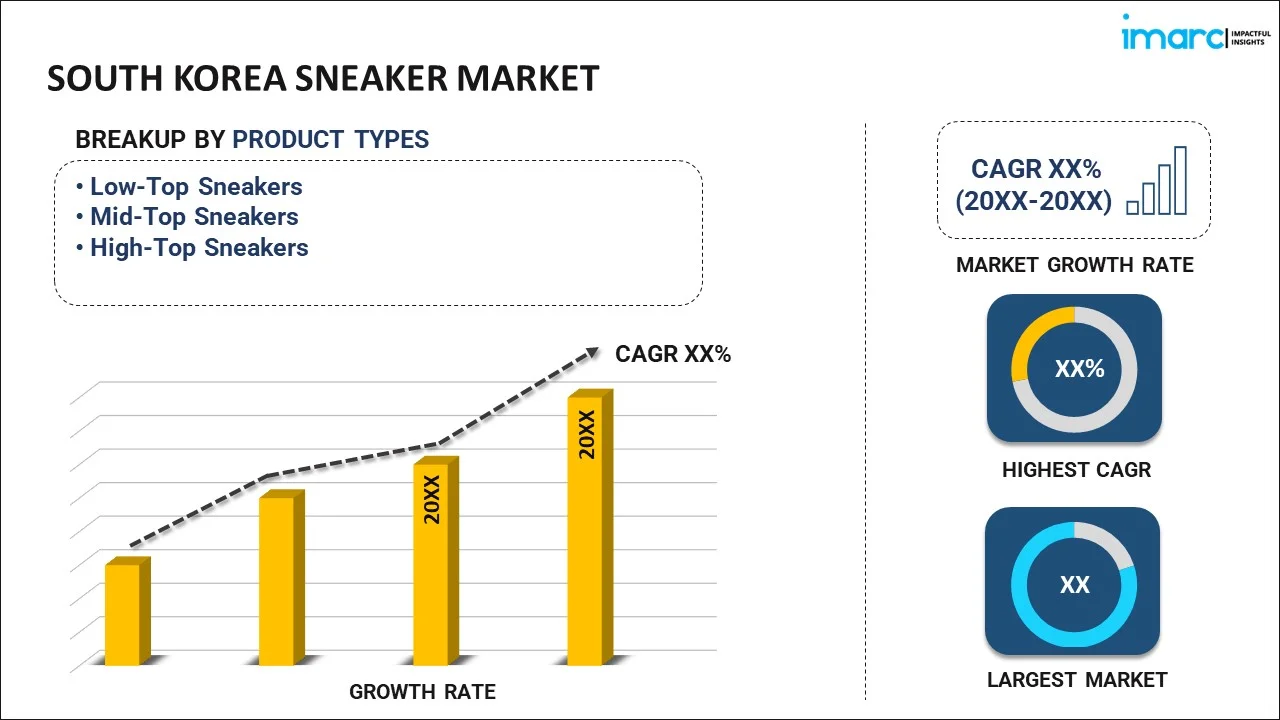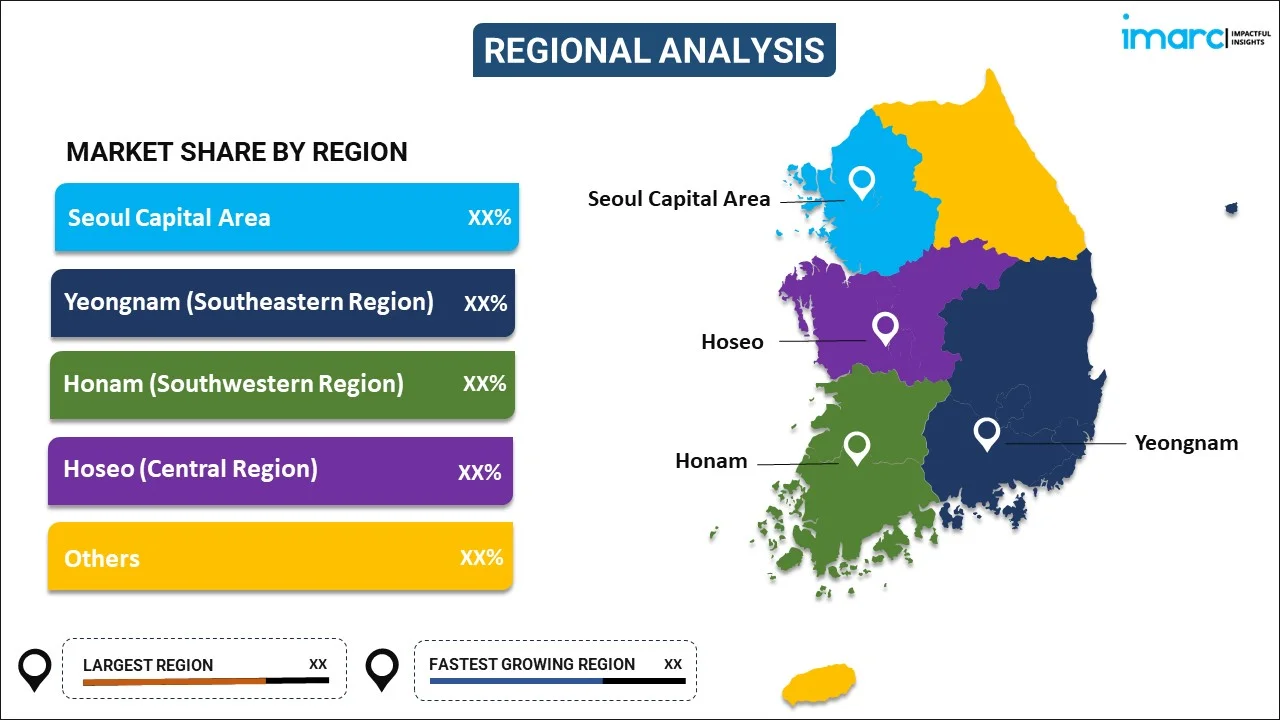
South Korea Sneaker Market Report by Product Type (Low-Top Sneakers, Mid-Top Sneakers, High-Top Sneakers), Category (Branded, Private Label), Price Point (Luxury, Economic), Distribution Channel (Specialty Stores, Supermarkets and Hypermarkets, Brand Outlets, Online Stores, and Others), End User (Men, Women, Kids), and Region 2024-2032
Market Overview:
South Korea sneaker market size is projected to exhibit a growth rate (CAGR) of 4.60% during 2024-2032. The widespread adoption of sustainable production methods by leading manufacturers, coupled with the inflating popularity of celebrity endorsements, is primarily driving the market growth across the country.
|
Report Attribute
|
Key Statistics
|
|---|---|
|
Base Year
|
2023 |
|
Forecast Years
|
2024-2032
|
|
Historical Years
|
2018-2023
|
| Market Growth Rate (2024-2032) | 4.60% |
Sneakers, commonly utilized for outdoor activities, are typically crafted from canvas with a rubber sole. The sole, fashioned from leather, synthetic fabrics, and mesh, undergoes specialized machinery processing. Primarily worn for physical pursuits like running, walking, sports, and everyday casual use, sneakers are designed to offer foot support and cushioning. Constructed with breathable materials, they are often paired with casual attire such as jeans or shorts. The intent is to prevent injuries and furnish ankle support to avert twisting and rolling. Sneakers are recognized for providing excellent traction, along with robust arch, heel, and toe support, thereby reducing the risk of slips and falls. The flexibility and composition of sneakers cater to diverse activities, ensuring comfort and protection for the feet.
South Korea Sneaker Market Trends:
South Korea's sneaker market is driven by a fusion of the emerging fashion trends and local preferences, reflecting the country's dynamic consumer landscape. The rise of athleisure culture and a growing emphasis on health and fitness contribute significantly to the demand for sneakers. Additionally, the individuals in South Korea embrace sneakers not only for sports and outdoor activities but also as a fashion statement in daily life, thereby positively influencing the regional market. Besides this, international collaborations between South Korean brands and global sneaker giants amplify the market's appeal, creating limited-edition releases and exclusive designs. Moreover, the country's influential pop culture, particularly K-pop and K-drama, further shapes sneaker preferences, with fans often seeking to emulate the footwear choices of their favorite celebrities. Apart from this, sustainability emerges as a prominent trend, with eco-friendly materials and ethical production practices gaining traction. Consumers increasingly prioritize brands committed to environmental responsibility. South Korea remains a dynamic hub, blending celebrity influences with local tastes to drive innovation and set trends in the ever-evolving world of footwear, which is anticipated to fuel the market growth over the forecasted period.
South Korea Sneaker Market Segmentation:
IMARC Group provides an analysis of the key trends in each segment of the market, along with forecasts at the regional and country levels for 2024-2032. Our report has categorized the market based on product type, category, price point, distribution channel, and end user.
Product Type Insights:

- Low-Top Sneakers
- Mid-Top Sneakers
- High-Top Sneakers
The report has provided a detailed breakup and analysis of the market based on the product type. This includes low-top sneakers, mid-top sneakers, and high-top sneakers.
Category Insights:
- Branded
- Private Label
A detailed breakup and analysis of the market based on the category have also been provided in the report. This includes branded and private label.
Price Point Insights:
- Luxury
- Economic
The report has provided a detailed breakup and analysis of the market based on the price point. This includes luxury and economic.
Distribution Channel Insights:
- Specialty Stores
- Supermarkets and Hypermarkets
- Brand Outlets
- Online Stores
- Others
A detailed breakup and analysis of the market based on the distribution channel have also been provided in the report. This includes specialty stores, supermarkets and hypermarkets, brand outlets, online stores, and others.
End User Insights:
- Men
- Women
- Kids
The report has provided a detailed breakup and analysis of the market based on the end user. This includes men, women, and kids.
Regional Insights:

- Seoul Capital Area
- Yeongnam (Southeastern Region)
- Honam (Southwestern Region)
- Hoseo (Central Region)
- Others
The report has also provided a comprehensive analysis of all the major regional markets, which include Seoul Capital Area, Yeongnam (Southeastern Region), Honam (Southwestern Region), Hoseo (Central Region), and Others.
Competitive Landscape:
The market research report has also provided a comprehensive analysis of the competitive landscape. Competitive analysis such as market structure, key player positioning, top winning strategies, competitive dashboard, and company evaluation quadrant has been covered in the report. Also, detailed profiles of all major companies have been provided.
South Korea Sneaker Market Report Coverage:
| Report Features | Details |
|---|---|
| Base Year of the Analysis | 2023 |
| Historical Period | 2018-2023 |
| Forecast Period | 2024-2032 |
| Units | Billion US$ |
| Scope of the Report | Exploration of Historical and Forecast Trends, Industry Catalysts and Challenges, Segment-Wise Historical and Predictive Market Assessment:
|
| Product Types Covered | Low-Top Sneakers, Mid-Top Sneakers, High-Top Sneakers |
| Categories Covered | Branded, Private Label |
| Price Points Covered | Luxury, Economic |
| Distribution Channels Covered | Specialty Stores, Supermarkets and Hypermarkets, Brand Outlets, Online Stores, Others |
| End Users Covered | Men, Women, Kids |
| Regions Covered | Seoul Capital Area, Yeongnam (Southeastern Region), Honam (Southwestern Region), Hoseo (Central Region), Others |
| Customization Scope | 10% Free Customization |
| Report Price and Purchase Option | Single User License: US$ 3699 Five User License: US$ 4699 Corporate License: US$ 5699 |
| Post-Sale Analyst Support | 10-12 Weeks |
| Delivery Format | PDF and Excel through Email (We can also provide the editable version of the report in PPT/Word format on special request) |
Key Questions Answered in This Report:
- How has the South Korea sneaker market performed so far and how will it perform in the coming years?
- What has been the impact of COVID-19 on the South Korea sneaker market?
- What is the breakup of the South Korea sneaker market on the basis of product type?
- What is the breakup of the South Korea sneaker market on the basis of category?
- What is the breakup of the South Korea sneaker market on the basis of price point?
- What is the breakup of the South Korea sneaker market on the basis of distribution channel?
- What is the breakup of the South Korea sneaker market on the basis of end user?
- What are the various stages in the value chain of the South Korea sneaker market?
- What are the key driving factors and challenges in the South Korea sneaker?
- What is the structure of the South Korea sneaker market and who are the key players?
- What is the degree of competition in the South Korea sneaker market?
Key Benefits for Stakeholders:
- IMARC’s industry report offers a comprehensive quantitative analysis of various market segments, historical and current market trends, market forecasts, and dynamics of the South Korea sneaker market from 2018-2032.
- The research report provides the latest information on the market drivers, challenges, and opportunities in the South Korea sneaker market.
- Porter's five forces analysis assist stakeholders in assessing the impact of new entrants, competitive rivalry, supplier power, buyer power, and the threat of substitution. It helps stakeholders to analyze the level of competition within the South Korea sneaker industry and its attractiveness.
- Competitive landscape allows stakeholders to understand their competitive environment and provides an insight into the current positions of key players in the market.
Need more help?
- Speak to our experienced analysts for insights on the current market scenarios.
- Include additional segments and countries to customize the report as per your requirement.
- Gain an unparalleled competitive advantage in your domain by understanding how to utilize the report and positively impacting your operations and revenue.
- For further assistance, please connect with our analysts.
 Inquire Before Buying
Inquire Before Buying
 Speak to an Analyst
Speak to an Analyst
 Request Brochure
Request Brochure
 Request Customization
Request Customization




.webp)




.webp)












